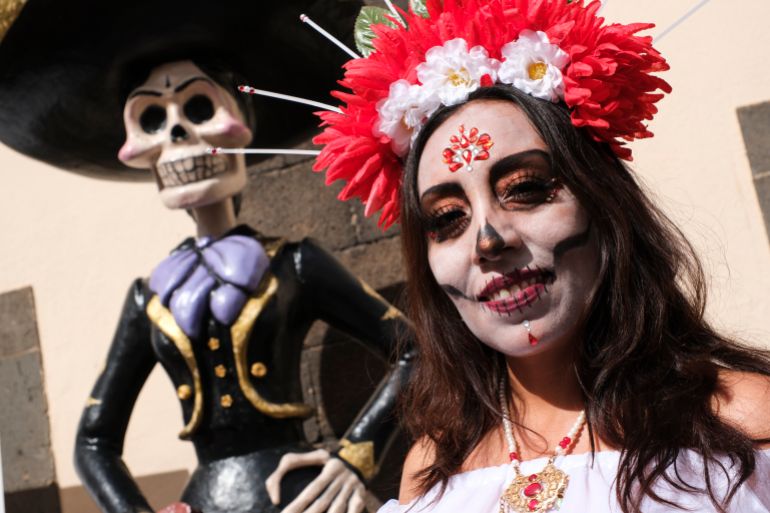Mexican homes and streets have been decorated with marigold flowers, candles, and sugar skulls this week.
Mexicans are gearing up for the country’s most significant holiday, El Dia de los Muertos, which kicks off this weekend.
In honor of their deceased relatives, Mexican families will gather in homes and cemeteries. The day is full of lively parades and rituals, including hot chocolate and Mexican street food, as well as elaborate altar decorations and desserts.
It’s a celebration of life, not death.
El Dia de los Muertos, or The Day of the Dead, is a celebration of the lives of those who have passed rather than mourning or grieving.
The living and the dead are said to have had a connection during this time. Traditional rituals, such as offering certain food items and putting marigold flowers on altars, are believed to assist spirits in visiting the dead.
People wear colorful skeleton costumes as well to honor the dead.
Indigenous roots are present in The Day of the Dead.
The ancient Aztec belief that death is a continuation of life is the inspiration for the festival. There are descendants of the Aztecs today, primarily in Mexico.
The Aztecs, who lived in central Mexico from the 14th to the 16th centuries, held month-long celebrations for the deceased.
In these celebrations, they also paid tribute to Mictecacihuatl, the goddess of the underworld, and made offerings of food and items for her.
All Saints’ Day on November 1 and All Souls’ Day on November 2 were the two Catholic holidays that the Spanish colonists introduced to Mexico in 1519.
These two days eventually became the Day of the Dead.
Families build altars for the deceased.
In their homes and in cemeteries, families place altars containing offerings for deceased loved ones and ancestors, which are known as “ofrendas.”
The steps to heaven are represented by two levels of heaven and earth, three levels of purgatory, and seven levels of earth signification.
The altars also have items made of the four elements: water to quench visitors’ thirst, fire to guide the spirits, earth, which is represented by food and special items for the deceased, and air, which is represented by vibrant paper designs. Salt, which is thought to aid souls on their way to the afterlife, is also present in some altars.
Additionally, these altars have marigold flowers, marigolds, and other images of the deceased, as well as their favorite foods, candles, and marigolds, which are thought to help spirits return from the cemetery to their families’ homes.

Additionally, the altars have “calaveras” (skulls), which are written in tongue-in-cheek about the deceased loved ones. These poems describe interesting behavior and funny tales that occurred during the lives of the deceased.
Skulls, a symbol of the perpetual nature of life and death, are a common sight on the Day of the Dead. The edible and decorative skull models made of sugar, clay, or papier-mache, or “calavera de azucar,” are used to decorate altars.

The “bread of the dead,” or “pan de muerto,” is a circular loaf of bread decorated with bone-shaped designs, is another popular food item during the festival. The bread is typically decorated with sugar to represent the sorrowful tears that loved ones have shed.
On both days of the festival, the bread is baked and consumed, and it is also offered at the altars.
Users can also create virtual altars on websites like MiAltar. These can be shared through the website.
La Catrina presides over parades.
La Catrina, who is tall and skeletal, can be seen all over the festival.
Political cartoonist and lithographer Jose Guadalupe Posada made her a character in the early 1900s.

A fashionable French hat and feathers are on La Catrina. Posada’s writings were a counterpoint to the Mexicans’ desire to imitate the elite of Europe.
Posada’s famous saying, “We are all skeletons,” makes reference to how we are all the same in the absence of expensive clothing, jewelry, and other accessories.
In a 1947 mural, Diego Rivera named Posada after her in the Latin word “the rich” (the rich) and added her name.

Day of the Dead is a daylong event that goes on for more than one day.
November 1 and November 2 are the main days of the holiday. However, some countries start their celebrations on October 27, which also includes their deceased pets. The following days are dedicated to creating altars.
The Philippines, which was colonized by Spain in 1565, are also celebrated throughout Latin America, including in Spain, some areas of the country with large Mexican-American populations, and in Mexico, where the Day of the Dead is celebrated.
The month of November is typically dedicated to “angelitos” (little angels), which are typically referred to as “angelitos” (little angels). Toys and balloons are adorn their graves.
Source: Aljazeera

Leave a Reply